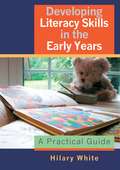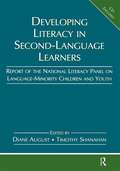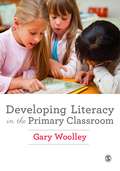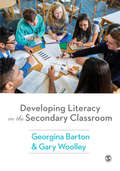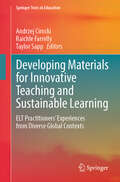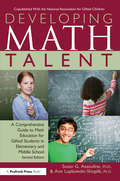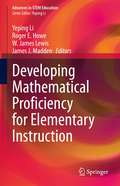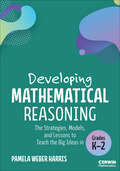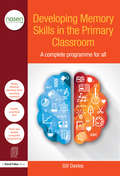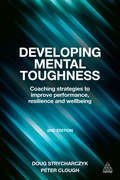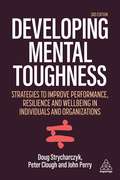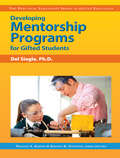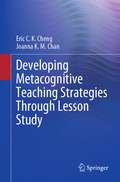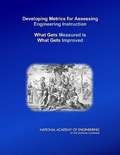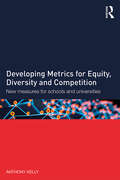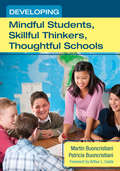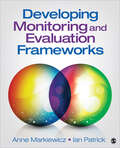- Table View
- List View
Developing Literacy Skills in the Early Years: A Practical Guide
by Hilary White'I found this book to be very useful and would recommend it to all infant teachers, especially those working with children with special needs. . . It gave me plenty of new ideas, and would be especially helpful to newly trained teachers' - REACH Many young children need targeted support and encouragement to help develop their literacy skills. This book contains tried and tested activities to improve listening, verbal reasoning and language skills in young children and shows you how to turn theory into fun, practical ideas for the classroom. The author shows how to link activities to the Early Learning Goals and the National Literacy Strategy and the book includes: - lesson activities using puppets, nursery rhymes, story boxes and picture books; - suggestions for using role-play; - ideas for organising your play setting to encourage literacy-related play; - lesson plans; - assessment guidelines; - lists of resources; - a selection of photocopiable material. This book is a valuable resource for those working with children aged 3 to 8 and those working in playgroups, day nurseries, nursery schools and reception classes will find it particularly useful. It suggests ways to improve young children's literacy skills and can also be used as an INSET resource to share with the whole staff. Hilary White is a freelance writer, consultant and teacher. She lectured for many years in an early years training college.
Developing Literacy and the Arts in Schools
by Georgina BartonThe teaching of the arts and literacy in schools is often at odds with one another. The desire for schools to improve results on high-stakes testing can lead to a narrow view of literacy rather than one that acknowledges the unique and distinct literacies that exist in other curriculum areas including the arts. With methods of communication becoming increasingly complex, it will be more and more important for students to be able to utilise all semiotic modes. Developing Literacy and the Arts in Schools investigates this key issue in education and offers a solution to the negative relationship between the arts and literacy. Drawing on interview data and evidence from diverse classrooms, it explores the pedagogies of effective arts practitioners and teachers, and how they relate to theoretical frameworks, to unpack the key elements of effective practice related to literacy and the arts. A model of arts-literacies is provided to assist arts and literacy educators in developing a common language that acknowledges and values these distinct arts-literacies. Themes of multimodality, diversity, aesthetics and reflection in relation to the arts and literacy are foregrounded throughout. This book will be of great value to postgraduate students of Education specialising in arts and literacy, education academics, teacher educators, and classroom and preservice teachers.
Developing Literacy in Second-Language Learners: Report of the National Literacy Panel on Language-Minority Children and Youth
by Timothy Shanahan Diane AugustThis volume reports the findings of the National Literacy Panel on Language-Minority Children and Youth. The formal charge to the panel—a distinguished group of expert researchers in reading, language, bilingualism, research methods, and education—was to identify, assess, and synthesize research on the education of language-minority children and youth with respect to their attainment of literacy. Funding for the project was provided to the Center for Applied Linguistics and SRI International by the U.S. Department of Education’s Institute of Education Sciences and the Office of English Language Acquisition, with additional funding from the National Institute of Child Health and Human Development provided through the U.S. Department of Education. The authors review the state of knowledge on the development of literacy in language-minority children and youth, organized around five specific themes:*Development of Literacy in Second-Language Learners;*Cross-linguistic Relationships in Second-Language Learners;*Sociocultural Contexts and Literacy Development*Educating Language-Minority Students: Instruction and Professional Development; and*Student Assessment Each part begins with a synthesis chapter that spells out the research questions for the chapters in that part, provides background information, describes the methodology used, summarizes the empirical findings reported, addresses methodological issues, and makes recommendations for future research. The following chapters provide more detail on the individual studies reviewed for specific research questions. The volume includes two opening chapters, “Introduction and Methodology” and “Demographic Overview”; a closing chapter that summarizes the report, identifies cross-cutting themes, and makes recommendations for future research; and a CD-ROM providing a searchable database of research references. The audiences for this volume include researchers interested in the development of literacy in language-minority children and youth as well as those studying literacy more generally, and those concerned with improving the education of this population of students.
Developing Literacy in the Primary Classroom
by Gary WoolleyPrimary literacy involves many different learning processes, which can make it challenging to teach, particularly in diverse classroom environments. Combining an examination of theory and research with practical case studies and real examples of teaching practice, this book shows trainee and early career teachers how to engage and motivate children to develop a range of primary English skills. Chapters incorporate broader aspects of primary teaching such as active learning, self-regulation and assessment, and activities and discussion points explore how to apply important principles to your own teaching. Drawing from international research and aware of policy developments in different countries, the book covers key topics on primary teacher education courses, including: The foundations of reading, writing and oracy skills Planning, assessment and classroom organisation Using new technologies and social media as tools for learning Engaging with the literacy needs of diverse learners. This is essential reading for students on university-based and school-based courses preparing to teach in primary education, and early career teachers seeking to continue their professional learning. Dr Gary Woolley is senior lecturer at the University of the Sunshine Coast, Australia.
Developing Literacy in the Primary Classroom
by Gary WoolleyPrimary literacy involves many different learning processes, which can make it challenging to teach, particularly in diverse classroom environments. Combining an examination of theory and research with practical case studies and real examples of teaching practice, this book shows trainee and early career teachers how to engage and motivate children to develop a range of primary English skills. Chapters incorporate broader aspects of primary teaching such as active learning, self-regulation and assessment, and activities and discussion points explore how to apply important principles to your own teaching. Drawing from international research and aware of policy developments in different countries, the book covers key topics on primary teacher education courses, including: The foundations of reading, writing and oracy skills Planning, assessment and classroom organisation Using new technologies and social media as tools for learning Engaging with the literacy needs of diverse learners. This is essential reading for students on university-based and school-based courses preparing to teach in primary education, and early career teachers seeking to continue their professional learning. Dr Gary Woolley is senior lecturer at the University of the Sunshine Coast, Australia.
Developing Literacy in the Secondary Classroom
by Gary Woolley Georgina BartonToday’s secondary classrooms are increasingly diverse places and skilled English teachers need to be able to develop flexible teaching strategies that can be adapted to best serve diverse learners with divergent needs. This textbook for pre-service teachers gives them pragmatic guidance on the major aspects of literacy teaching, and how to draw insight research and apply it in diverse classrooms. Key coverage includes: · The fundamental aspects of teaching reading and writing to adolescent learners. · How to intelligently select and use literature with secondary students. · Multi-literacies and the use of technology in English teaching. · Assessment strategies for the classroom. · Teaching techniques for developing reading comprehension. This is essential reading for anyone training to teach English in secondary classrooms, and for recently qualified teachers looking to sharpen their practice.
Developing Literacy in the Secondary Classroom
by Gary Woolley Georgina BartonToday’s secondary classrooms are increasingly diverse places and skilled English teachers need to be able to develop flexible teaching strategies that can be adapted to best serve diverse learners with divergent needs. This textbook for pre-service teachers gives them pragmatic guidance on the major aspects of literacy teaching, and how to draw insight research and apply it in diverse classrooms. Key coverage includes: · The fundamental aspects of teaching reading and writing to adolescent learners. · How to intelligently select and use literature with secondary students. · Multi-literacies and the use of technology in English teaching. · Assessment strategies for the classroom. · Teaching techniques for developing reading comprehension. This is essential reading for anyone training to teach English in secondary classrooms, and for recently qualified teachers looking to sharpen their practice.
Developing Materials for Innovative Teaching and Sustainable Learning: ELT Practitioners’ Experiences from Diverse Global Contexts (Springer Texts in Education)
by Andrzej Cirocki Raichle Farrelly Taylor SappThis volume features current, innovative, and effective ways of developing instructional materials for diverse English Language Teaching (ELT) contexts. It is divided into four sections, each featuring pedagogical materials designed for specific groups of learners. The sections focus on materials for general English, ESP and EAP, CLIL, and ELT teacher education courses. The chapters, written by experienced educators from around the world, are highly practical and detail the process of designing materials for innovative and sustainable language education. The contributors reflect on their own practice, describe the materials design process, explain the guiding principles, and connect the design process with the local context and educational policies. They also offer practical tips to inspire classroom practitioners to create their own materials, promoting innovative teaching and sustainable learning. Ultimately, their chapters aim to encourage a world where teaching involves creativity and adaptability, leading to transformative learning for both teachers and learners.
Developing Math Talent
by Ann Lupowski-Shoplik Susan G. AssoulineBuild student success in math with the only comprehensive guide for developing math talent among advanced learners. The authors, nationally recognized math education experts, offer a focused look at educating gifted and talented students for success in math. More than just a guidebook for educators, this book offers a comprehensive approach to mathematics education for gifted students of elementary or middle school age.
Developing Math Talent: A Comprehensive Guide to Math Education for Gifted Students in Elementary and Middle School
by Susan G. Assouline Ann Lupkowski-ShoplikBuild student success in math with the only comprehensive guide for developing math talent among advanced learners. The authors, nationally recognized math education experts, offer a focused look at educating gifted and talented students for success in math. More than just a guidebook for educators, this book offers a comprehensive approach to mathematics education for gifted students of elementary or middle school age.The authors provide concrete suggestions for identifying mathematically talented students, tools for instructional planning, and specific programming approaches. Developing Math Talent features topics such as strategies for identifying mathematically gifted learners, strategies for advocating for gifted children with math talent, how to design a systematic math education program for gifted students, specific curricula and materials that support success, and teaching strategies and approaches that encourage and challenge gifted learners.
Developing Mathematical Proficiency for Elementary Instruction (Advances in STEM Education)
by Yeping Li W. James Lewis James J. Madden Roger E. HoweThe need to improve the mathematical proficiency of elementary teachers is well recognized, and it has long been of interest to educators and researchers in the U.S. and many other countries. But the specific proficiencies that elementary teachers need and the process of developing and improving them remain only partially conceptualized and not well validated empirically. To improve this situation, national workshops were organized at Texas A&M University to generate focused discussions about this important topic, with participation of mathematicians, mathematics educators and teachers. Developing Mathematical Proficiency for Elementary Instruction is a collection of articles that grew out of those exciting cross-disciplinary exchanges. Developing Mathematical Proficiency for Elementary Instruction is organized to probe the specifics of mathematical proficiency that are important to elementary teachers during two separate but inter-connected professional stages: as pre-service teachers in a preparation program, and as in-service teachers teaching mathematics in elementary classrooms. From this rich and inspiring collection, readers may better understand, and possibly rethink, their own practices and research in empowering elementary teachers mathematically and pedagogically, as educators or researchers.
Developing Mathematical Reasoning: Avoiding the Trap of Algorithms (Corwin Mathematics Series)
by Pamela Weber HarrisMath is not rote-memorizable. Math is not random-guessable. Math is figure-out-able. Author Pam Harris argues that teaching real math—math that is free of distortions–will reach more students more effectively and result in deeper understanding and longer retention. This book is about teaching undistorted math using the kinds of mental reasoning that mathematicians do. Memorization tricks and algorithms meant to make math "easier" are full of traps that sacrifice long-term student growth for short-lived gains. Students and teachers alike have been led to believe that they’ve learned more and more math, but in reality their brains never get any stronger. Using these tricks may make facts easier to memorize in isolation, but that very disconnect distorts the reality of math. The mountain of trivia piles up until students hit a breaking point. Humanity′s most powerful system of understanding, organizing, and making an impact on the world becomes a soul-draining exercise in confusion, chaos, and lost opportunities. Developing Mathematical Reasoning: Avoiding the Trap of Algorithms emphasizes the importance of teaching students increasingly sophisticated mathematical reasoning and understanding underlying concepts rather than relying on a set rule for solving problems. This book illuminates a hierarchy of mathematical reasoning to help teachers guide students through various domains of math development, from basic counting and adding to more complex proportional and functional reasoning. Everyone is capable of understanding and doing real math. This book: Highlights the important mathematical relationships, strategies, and models for students to develop Offers personal stories, reflection sections, and extensive practical exercises for easy implementation Includes real math—a lot of it—to provide teachers with examples they can put to use in their classrooms immediately This book is a valuable resource for educators looking to reach more students by building a strong foundation of mathematical thinking in their students. By addressing common misconceptions about math and providing practical strategies for teaching real math, this book shows that everyone can use the mathematical relationships they already know to reason about new relationships. In other words, everyone can math.
Developing Mathematical Reasoning: Avoiding the Trap of Algorithms (Corwin Mathematics Series)
by Pamela Weber HarrisMath is not rote-memorizable. Math is not random-guessable. Math is figure-out-able. Author Pam Harris argues that teaching real math—math that is free of distortions–will reach more students more effectively and result in deeper understanding and longer retention. This book is about teaching undistorted math using the kinds of mental reasoning that mathematicians do. Memorization tricks and algorithms meant to make math "easier" are full of traps that sacrifice long-term student growth for short-lived gains. Students and teachers alike have been led to believe that they’ve learned more and more math, but in reality their brains never get any stronger. Using these tricks may make facts easier to memorize in isolation, but that very disconnect distorts the reality of math. The mountain of trivia piles up until students hit a breaking point. Humanity′s most powerful system of understanding, organizing, and making an impact on the world becomes a soul-draining exercise in confusion, chaos, and lost opportunities. Developing Mathematical Reasoning: Avoiding the Trap of Algorithms emphasizes the importance of teaching students increasingly sophisticated mathematical reasoning and understanding underlying concepts rather than relying on a set rule for solving problems. This book illuminates a hierarchy of mathematical reasoning to help teachers guide students through various domains of math development, from basic counting and adding to more complex proportional and functional reasoning. Everyone is capable of understanding and doing real math. This book: Highlights the important mathematical relationships, strategies, and models for students to develop Offers personal stories, reflection sections, and extensive practical exercises for easy implementation Includes real math—a lot of it—to provide teachers with examples they can put to use in their classrooms immediately This book is a valuable resource for educators looking to reach more students by building a strong foundation of mathematical thinking in their students. By addressing common misconceptions about math and providing practical strategies for teaching real math, this book shows that everyone can use the mathematical relationships they already know to reason about new relationships. In other words, everyone can math.
Developing Mathematical Reasoning: The Strategies, Models, and Lessons to Teach the Big Ideas in Grades K-2 (Corwin Mathematics Series)
by Pamela Weber HarrisMath is not rote-memorizable. Math is not random-guessable. Math is figure-out-able. Author Pam Harris argues that teaching real math—math that is free of distortions—will reach more students more effectively and result in deeper understanding and longer retention. This book is about teaching undistorted math using the kinds of mental reasoning that mathematicians do. Memorization tricks and algorithms meant to make math "easier" are full of traps that sacrifice long-term student growth for short-lived gains. Students and teachers alike have been led to believe that they’ve learned more and more math, but in reality their brains never get any stronger. Using these tricks may make facts easier to memorize in isolation, but that very disconnect distorts the reality of math. In her landmark book Developing Mathematical Reasoning: Avoiding the Trap of Algorithms, Pam emphasizes the importance of teaching students increasingly sophisticated mathematical reasoning and understanding underlying concepts rather than relying on a set rule for solving problems. Now, in this first companion volume, Developing Mathematical Reasoning: The Strategies, Models, and Lessons to Teach the Big Ideas in Grades K-2, she demonstrates how counting and additive strategies serve as the foundation for creating efficient, accurate, and flexible thinkers. Everyone is capable of understanding and doing real math. This book: Gives step-by-step guidance on how to teach the strategies, models, and big ideas that foster confidence and long-term success, preparing students for increasingly complex mathematical challenges Offers the "what to do" to teach counting, addition, and subtraction in ways that promote reasoning over rote memorization Provides practical tools such as problem strings, models, classroom routines, and discussion questions designed to implement reasoning-based practices Includes supporting resources for creating a classroom culture where students see math as figure-out-able and gain confidence as mathematical thinkers By addressing common misconceptions about math and providing practical strategies for teaching real math, this book shows that everyone can use the mathematical relationships they already know to reason about new relationships. In other words, everyone can math-even the very youngest students!
Developing Mathematical Reasoning: The Strategies, Models, and Lessons to Teach the Big Ideas in Grades K-2 (Corwin Mathematics Series)
by Pamela Weber HarrisMath is not rote-memorizable. Math is not random-guessable. Math is figure-out-able. Author Pam Harris argues that teaching real math—math that is free of distortions—will reach more students more effectively and result in deeper understanding and longer retention. This book is about teaching undistorted math using the kinds of mental reasoning that mathematicians do. Memorization tricks and algorithms meant to make math "easier" are full of traps that sacrifice long-term student growth for short-lived gains. Students and teachers alike have been led to believe that they’ve learned more and more math, but in reality their brains never get any stronger. Using these tricks may make facts easier to memorize in isolation, but that very disconnect distorts the reality of math. In her landmark book Developing Mathematical Reasoning: Avoiding the Trap of Algorithms, Pam emphasizes the importance of teaching students increasingly sophisticated mathematical reasoning and understanding underlying concepts rather than relying on a set rule for solving problems. Now, in this first companion volume, Developing Mathematical Reasoning: The Strategies, Models, and Lessons to Teach the Big Ideas in Grades K-2, she demonstrates how counting and additive strategies serve as the foundation for creating efficient, accurate, and flexible thinkers. Everyone is capable of understanding and doing real math. This book: Gives step-by-step guidance on how to teach the strategies, models, and big ideas that foster confidence and long-term success, preparing students for increasingly complex mathematical challenges Offers the "what to do" to teach counting, addition, and subtraction in ways that promote reasoning over rote memorization Provides practical tools such as problem strings, models, classroom routines, and discussion questions designed to implement reasoning-based practices Includes supporting resources for creating a classroom culture where students see math as figure-out-able and gain confidence as mathematical thinkers By addressing common misconceptions about math and providing practical strategies for teaching real math, this book shows that everyone can use the mathematical relationships they already know to reason about new relationships. In other words, everyone can math-even the very youngest students!
Developing Memory Skills in the Primary Classroom: A complete programme for all (nasen spotlight)
by Gill DaviesHow can we help children to develop their working memory? The memory demands in the classroom for children are high; they are constantly bombarded by new knowledge in multiple topic areas, given series of instructions to complete and expected to both learn and demonstrate their mastery of knowledge and skills on a daily basis. Developing Memory Skills in the Primary Classroom is a highly practical book that contains all the guidance and resources a school needs to boost their pupils’ working memory. Proven to have a positive impact on pupils, this tried and tested complete programme combines teaching pupils memory strategies with opportunities to practice those strategies within a small group, the classroom and at home. The resources provided by this book include: a variety of photocopiable games and activities extensive teaching notes a range of sample letters to parents/carers essential information sheets bespoke baseline assessment tools a detailed programme that can be run by a teaching assistant under the guidance of the SENCo. This text provides a clear link between working in the classroom and with parents in the home, making it a one-stop resource for any teacher, SENCo, teaching assistant or parent wanting to help children develop their working memory.
Developing Mental Toughness
by Peter Clough Doug StrycharczykMental toughness is about how effectively individuals respond to stress, pressure and challenge. It is rooted in the notion of resilience but moves beyond this by being highly applicable and measurable. Understanding this concept is essential to improving performance for both the individual and organization, and this ground-breaking book explains mental toughness clearly and effectively. Tracing its development from sports psychology into the world of business, health and education, Developing Mental Toughness was the first book to look at applications at the organizational level and to provide a reliable psychometric measure. The new edition includes greater coverage of how mental toughness relates to other behaviours and can be applied to leadership, creativity, emotional intelligence, and motivation. It also looks at its applications in employability and entrepreneurship, and there will be expanded coverage of coaching for mental toughness. Written for anyone coaching individuals and teams for improved performance, the book contains practical guidance and techniques, exercises, case studies and the Mental Toughness self-assessment tool.
Developing Mental Toughness: Strategies to Improve Performance, Resilience and Wellbeing in Individuals and Organizations
by John Perry Peter Clough Doug StrycharczykHow can individuals and organizations understand and measure mental toughness to deal with stress and challenge, and so improve performance? This fully updated third edition of Developing Mental Toughness provides the answers to unlock this potential.Tracing its development from sports psychology into the business sector, Developing Mental Toughness provides a reliable psychometric measure to apply at the organizational level. With coverage on how mental toughness relates to other behaviours and can be applied to employability, leadership, performance, creativity, emotional intelligence and motivation, the practical guidance and exercises in this book make it essential reading for academics, managers and coaches alike.This third edition includes an expansion of the 4Cs model to include concepts on learning orientation and resilience and new chapters on evidence-based practice and using the Mental Toughness Questionnaire (MTQ48) to gain richer self-awareness. Featuring case studies from Deloitte and Ethiad, Developing Mental Toughness is the practical coaching guide for developing capabilities and resilience.
Developing Mentorship Programs for Gifted Students
by Del SiegleMentorship programs can provide motivated gifted and talented students with an opportunity to apply inductive thinking and problem-solving skills to advanced content that is often associated with real-life situations. They need to investigate the complexities and interrelationships among disciplines that can only be discovered with assistance from highly knowledgeable experts. As gifted students develop their interests and talents in a chosen area of study, it is often necessary to structure learning experiences with out-of-school mentors. This guide offers practical strategies for starting and developing a mentoring program. From structuring a program, to selecting a mentor and monitoring progress, to ensuring success, this book provides an excellent introduction to the topic.
Developing Metacognitive Teaching Strategies Through Lesson Study
by Eric C. Cheng Joanna K. ChanThe book illustrates how Lesson Study can be applied to craft metacognitive teaching strategies to enhance students’ learning to learn competencies. Based on the findings of an empirical study of a university-funded teaching development project, this book reports how to apply Lesson Study and Learning Study to enhance teachers’ metacognitive teaching competencies with a view to tackling the impacts and challenges created by and underlying the learning to learn curriculum. The book allows readers to experience metacognitive learning by sorting the prior knowledge on the metacognition, setting the goal and planning reading schedule, checking their understanding and progress, evaluating what they have or have not learned and reflected on their reading experience and feelings. Readers can grasp the key concept underpinning metacognitive teaching, including teaching strategies for developing students’ metacognitive abilities that include working on problem-solving activities, working on small collaborative groups, making metacognitive and learning strategies explicit, and encouraging students to reflect upon and talk about their learning.
Developing Metrics for Assessing Engineering Instruction: What Gets Measured Is What Gets Improved
by National Academy of Enegineering National of the National AcademiesFaculty in all disciplines must continually prioritize their time to reflect the many demands of their faculty obligations, but they must also prioritize their efforts in ways that will improve the prospects of career advancement. The current perception is that research contributions are the most important measure with respect to faculty promotion and tenure decisions, and that teaching effectiveness is less valued--regardless of the stated weighting of research, teaching and service. In addition, methods for assessing research accomplishments are well established, even though imperfect, whereas metrics for assessing teaching, learning, and instructional effectiveness are not as well defined or well established. Developing Metrics for Assessing Engineering Instruction provides a concise description of a process to develop and institute a valid and acceptable means of measuring teaching effectiveness in order to foster greater acceptance and rewards for faculty efforts to improve their performance of the teaching role that makes up a part of their faculty responsibility. Although the focus of this book is in the area of engineering, the concepts and approaches are applicable to all fields in higher education.
Developing Metrics for Equity, Diversity and Competition: New measures for schools and universities
by Anthony KellyDeveloping Metrics for Equity, Diversity and Competition is a groundbreaking book in the field of educational research. Equity, diversity and competition are critical to our understanding of social justice and the provision of effective education for everyone, and this book develops a new coherent scientific approach to measuring them. New theory and methodologies based on previous research by the author are introduced in school and university settings. They are mathematical in nature, but have a wide range of applications within mixed-methods approaches and include: warranted weighting systems for constructing league tables game theoretic approaches to analysing power and influence indices for measuring equity in student attainment indices for measuring competition modelling the educational awards market calculating the optimal size of research groups measuring diversity. The book is an ideal resource for educational researchers, policy-makers and high-level practitioners, and those who want to explore the possibilities of using novel approaches to address the problems faced by schools, colleges and universities in the new education landscape.
Developing Mindful Students, Skillful Thinkers, Thoughtful Schools
by Martin Buoncristiani Patricia E. BuoncristianiLearning outside the box begins with a thought Grounded in the research of the best proponents of critical thinking and aligned to one of the key goals of the Common Core State Standards, this book shows school leaders how to build a thinking culture within the entire learning community. Included are numerous strategies for both teachers and leaders that demonstrate how to: Shape the school culture so that it promotes a common vision around thinking Create classroom conditions that help students become mindful thinkers Ask questions that develop skillful thinking Help students formulate questions that facilitate problem solving Work with parents to encourage skillful thinking in their children
Developing Monitoring and Evaluation Frameworks
by Anne Markiewicz Ian PatrickThis practical book provides clear, step-by-step guidance on how to develop a monitoring and evaluation framework in a participatory, logical, systematic, and integrated way. The authors outline the key stages and steps involved, including: scoping the framework; identifying planned results; using program theory and program logic; developing evaluation questions; identifying processes for ongoing data collection and analysis; determining means to promote learning; reporting; and dissemination of results. A final chapter focuses on planning for implementation of the framework, with reference to the broader program and organizational context. The authors draw on their extensive experience in developing monitoring and evaluation frameworks to provide examples of good practice that inform organizational learning and decision making, while offering tips and guidelines that can be used to address common pitfalls.
Developing Monitoring and Evaluation Frameworks
by Anne Markiewicz Ian PatrickThis practical book provides clear, step-by-step guidance on how to develop a monitoring and evaluation framework in a participatory, logical, systematic, and integrated way. The authors outline the key stages and steps involved, including: scoping the framework; identifying planned results; using program theory and program logic; developing evaluation questions; identifying processes for ongoing data collection and analysis; determining means to promote learning; reporting; and dissemination of results. A final chapter focuses on planning for implementation of the framework, with reference to the broader program and organizational context. The authors draw on their extensive experience in developing monitoring and evaluation frameworks to provide examples of good practice that inform organizational learning and decision making, while offering tips and guidelines that can be used to address common pitfalls.
